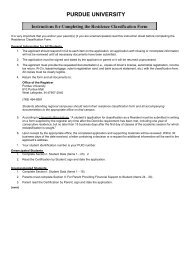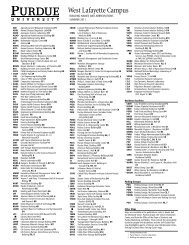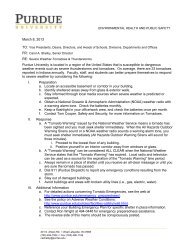Basic Mercury Data & Coal Fired Power Plants - Purdue University
Basic Mercury Data & Coal Fired Power Plants - Purdue University
Basic Mercury Data & Coal Fired Power Plants - Purdue University
Create successful ePaper yourself
Turn your PDF publications into a flip-book with our unique Google optimized e-Paper software.
CCTR<br />
Indiana Center for <strong>Coal</strong> Technology Research<br />
<strong>Basic</strong> <strong>Mercury</strong> <strong>Data</strong><br />
& <strong>Coal</strong> <strong>Fired</strong> <strong>Power</strong> <strong>Plants</strong><br />
CCTR <strong>Basic</strong> Facts File #2<br />
Brian H. Bowen, Marty W. Irwin<br />
The Energy Center at Discovery Park<br />
<strong>Purdue</strong> <strong>University</strong><br />
CCTR, Potter Center, 500 Central Drive<br />
West Lafayette, IN 47907-2022<br />
http://www.purdue.edu/dp/energy/CCTR/<br />
Email: cctr@ecn.purdue.edu<br />
March 2007<br />
1
CCTR Indiana Center for <strong>Coal</strong> Technology Research<br />
DOE Example<br />
Complexity of <strong>Mercury</strong> Controls<br />
If the Houston Astrodome were filled with ping-pong balls<br />
representing the quantity of flue gas emitted from coal-fired<br />
power plants in the U.S. each year, 30 Billion<br />
(30,000,000,000) ping pong balls would be required.<br />
<strong>Mercury</strong> emissions would be represented by 30 colored ping<br />
pong balls & the challenge by industry is to remove 21 of<br />
the 30 colored balls (for 70% compliance) from among<br />
the 30 Billion<br />
Source: “<strong>Coal</strong> Energy Systems”, Bruce G. Miller, 2005, p369<br />
2
CCTR Indiana Center for <strong>Coal</strong> Technology Research<br />
Three Forms of <strong>Mercury</strong> from <strong>Power</strong> <strong>Plants</strong><br />
The mercury emitted from power plants is measured<br />
as three forms:<br />
Elemental, Hg o<br />
Oxidized, Hg +2<br />
Condensed on ash particles, Hg p<br />
In the natural environment mercury can go through a<br />
series of chemical transformations to convert to a highly<br />
toxic form, methylmercury, CH 3 Hg which is<br />
concentrated in fish and birds<br />
Almost no mercury from the soil is taken into the shoots<br />
of plants<br />
Source: “<strong>Coal</strong> Energy Systems”, Bruce G. Miller, 2005, p.109<br />
3
CCTR Indiana Center for <strong>Coal</strong> Technology Research<br />
<strong>Mercury</strong> Types From <strong>Power</strong> <strong>Plants</strong><br />
• 40% of Hg from power plants is Oxidized Hg<br />
60% of Hg from power plants is Elemental Hg<br />
• Most of the Oxidized Hg and all of the<br />
Elemental Hg is carried away by the wind<br />
• Oxidized Hg is water-soluble. A small<br />
amount of the oxidized Hg ends up in water<br />
and may be formed into an organic form<br />
called Methylmercury. This is the Hg type<br />
eaten by fish<br />
Source: http://www.epa.gov/nrmrl/pubs/600r01109/600R01109chap9.pdf#search=%22mercury%20in%20coal%20slag%22<br />
4
CCTR Indiana Center for <strong>Coal</strong> Technology Research<br />
<strong>Mercury</strong> Emissions from <strong>Power</strong> <strong>Plants</strong><br />
Use of <strong>Coal</strong> Combustion By-Products (CCB) varies<br />
globally with 56% of CCBs being profitably used<br />
in Europe (1999) compared with about 30% in the U.S.<br />
Countries such as Canada, India, & Japan utilize<br />
27%, 13% & 84% of their CCBs, respectively<br />
<strong>Coal</strong> from China’s Guizhou Province has mercury<br />
concentration of 55ppm which is about 200 times the<br />
average mercury concentration in U.S. coals, 0.275ppm<br />
Source: “<strong>Coal</strong> Energy Systems”, Bruce G. Miller, 2005,<br />
5
CCTR Indiana Center for <strong>Coal</strong> Technology Research<br />
<strong>Coal</strong> washing<br />
removes 30% Hg<br />
75 Tons Hg per<br />
year from U.S.<br />
power plants<br />
U.S. <strong>Mercury</strong> <strong>Data</strong> for <strong>Power</strong> <strong>Plants</strong><br />
100%<br />
66%<br />
34%<br />
4%<br />
22%<br />
8% 30% to concrete<br />
70% to roofing, agriculture, wallboards,<br />
blasting grit, road base, drainage, fillers etc 12%<br />
50 Tons Hg emitted<br />
to the air < 1% of Hg<br />
globally emitted to the<br />
atmosphere per year<br />
25 Tons Hg reduction<br />
through existing<br />
pollution controls such<br />
as scrubbers for<br />
SO2, SCRs for NOx,<br />
and PM fabric filters<br />
17 Tons Hg to land fills<br />
8 Tons Hg commercial use<br />
6
CCTR Indiana Center for <strong>Coal</strong> Technology Research<br />
COAL<br />
PREPARATION<br />
<strong>Mercury</strong> Extraction Process<br />
61% of Hg remains<br />
POWER<br />
PLANT<br />
BOILERS<br />
Existing emissions technologies<br />
remove on average about 40% of the Hg.<br />
Hg removal rate can vary from 10% to 90%<br />
depending on coal type and pollution<br />
control devices<br />
<strong>Coal</strong> washing removes 25% to 35% of the Hg<br />
from the coal. In Indiana coal this is 39%<br />
EXISTING<br />
EMISSIONS<br />
CAPTURE<br />
SCRs remove NOx<br />
Scrubbers remove SO 2<br />
Fabric Filters remove PM<br />
15% Oxidized Hg<br />
22% Elemental Hg<br />
37% of Hg remains<br />
FUTURE<br />
MERCURY<br />
CAPTURE<br />
TECHNOLOGY<br />
7
CCTR Indiana Center for <strong>Coal</strong> Technology Research<br />
U.S. <strong>Mercury</strong> Emissions<br />
Source: /www.epa.gov/mercury/pdfs/I_HgReleases.pdf<br />
About 50 Tons per<br />
year of Hg is emitted<br />
from U.S. power plants<br />
Massive Hg reductions<br />
have been achieved at<br />
medical and municipal<br />
sites<br />
8
CCTR Indiana Center for <strong>Coal</strong> Technology Research<br />
<strong>Mercury</strong> from U.S. <strong>Power</strong> <strong>Plants</strong><br />
Majority of coal arriving at power plants has been washed<br />
and 25% to 35% of the Hg removed (Indiana = 39%)<br />
Approximately 75 Tons of Hg are found in the coal<br />
delivered to power plants each year and about<br />
two thirds of this Hg is emitted to the air, resulting<br />
in about 50 Tons being emitted annually. This 25 Ton<br />
reduction is achieved in the power plant boilers and<br />
through existing pollution controls such as scrubbers<br />
for SO2, SCRs for NOx, and PM fabric filters<br />
Source: http://www.epa.gov/mercury/control_emissions/index.htm<br />
9
CCTR Indiana Center for <strong>Coal</strong> Technology Research<br />
1999 U.S. Commercial Uses Of<br />
<strong>Coal</strong> Combustion By-Products, CCBs<br />
About 70% of the CCBs are land-disposed<br />
& the other 30% are reused or recycled for<br />
commercial uses<br />
33 Million Tons (MTons) of CCBs commercially used<br />
~ 3% of the total tonnage of coal produced in the<br />
U.S. (coal produced is 1100 Million Tons per year)<br />
10 MTons of CCBs are used for concrete<br />
~ the greatest current use of CCBs<br />
Source: http://www.epa.gov/nrmrl/pubs/600r01109/600R01109chap9.pdf#search=%22mercury%20in%20coal%20slag%22<br />
10
CCTR Indiana Center for <strong>Coal</strong> Technology Research<br />
<strong>Mercury</strong> Concentrations<br />
in <strong>Coal</strong> Combustion By-Products<br />
CCB<br />
Fly Ash<br />
Bottom Ash<br />
Boiler Slag<br />
Wet FGD scrubber<br />
solids/sludges<br />
Parts per Million<br />
ppm<br />
0.330<br />
0.067<br />
0.042<br />
0.200<br />
The Fly Ash contains over half of all the Hg<br />
emitted from coal fired power plants<br />
Source: http://www.epa.gov/nrmrl/pubs/600r01109/600R01109chap9.pdf#search=%22mercury%20in%20coal%20slag%22<br />
11
CCTR Indiana Center for <strong>Coal</strong> Technology Research<br />
U.S. <strong>Coal</strong> Combustion Residues<br />
108 MTons of total CCR<br />
~ 9.8% of total U.S. coal tonnage production<br />
Source: http://www.epa.gov/nrmrl/pubs/600r01109/600R01109chap9.pdf#search=%22mercury%20in%20coal%20slag%22<br />
108 MTons<br />
12
CCTR Indiana Center for <strong>Coal</strong> Technology Research<br />
1999 U.S. Commercial Uses of CCBs<br />
Source: http://www.epa.gov/nrmrl/pubs/600r01109/600R01109chap9.pdf#search=%22mercury%20in%20coal%20slag%22<br />
13
CCTR Indiana Center for <strong>Coal</strong> Technology Research<br />
<strong>Mercury</strong> Emissions from Utilities in 2000<br />
State<br />
TX<br />
PA<br />
OH<br />
IL<br />
IN<br />
Hg<br />
Emissions<br />
(Tons)<br />
5.13<br />
5.12<br />
3.83<br />
3.41<br />
2.63<br />
Hg<br />
Rank<br />
Indiana <strong>Coal</strong> has 5.2 lb Hg per TBtu = 5.2 lb Hg x 10-6 per MBtu<br />
(1lb = 16 oz, 1 Ton of Indiana coal has about 22 MBtu)<br />
= 5.2 x 10-6 x 16 x 22 = 0.0018 oz Hg per Ton <strong>Coal</strong><br />
≈ 1/500th oz of Hg per Ton of coal<br />
Sources: http://www.epa.gov/cleanenergy/egrid/index.htm<br />
http://www.eia.doe.gov/cneaf/coal/page/acr/table26.html<br />
1 st<br />
2 nd<br />
3 rd<br />
4 th<br />
5th<br />
14
CCTR Indiana Center for <strong>Coal</strong> Technology Research<br />
Indiana Emissions By Sector<br />
(1000 Tons)<br />
<strong>Mercury</strong><br />
15
CCTR Indiana Center for <strong>Coal</strong> Technology Research<br />
<strong>Mercury</strong> from 10 Largest Indiana<br />
<strong>Power</strong> Stations in 2000 (1.99 Tons)<br />
Station<br />
1. Gibson<br />
3131 MW<br />
2. Rockport<br />
2600 MW<br />
3. R M Schahfer<br />
1780 MW<br />
4. Petersburg<br />
1672 MW<br />
5. Clifty Crk.<br />
1209 MW<br />
6. Cayuga<br />
1096 MW<br />
7. Merom<br />
1000 MW<br />
8. Tanners Crk.<br />
980 MW<br />
9. Harding St.<br />
924 MW<br />
10. Wabash R.<br />
918 MW<br />
Utility<br />
Duke<br />
IMPCo<br />
NIPSCo<br />
IPL<br />
IKECorp<br />
Duke<br />
Hoosier<br />
IMPCo<br />
IPLCo<br />
Duke<br />
Hg Emission<br />
in 2000<br />
(pounds)<br />
100%<br />
Note: * Schahfer has 2 of its 6 units, 155MW, using Natural Gas<br />
Cayuga has 1 of its 3 units, 99MW, using Natural Gas<br />
Harding St has 3 of its 8 units, 322MW, using Natural Gas<br />
Wabash River has 1 of its 7 units as an IGCC & 2 units using Natural Gas<br />
Source: Form EIA 767, 2003<br />
640<br />
1109<br />
406<br />
284<br />
518<br />
224<br />
118<br />
299<br />
177<br />
201<br />
% IN coal<br />
of total coal<br />
used<br />
79%<br />
16%<br />
21%<br />
100%<br />
22%<br />
64%<br />
100%<br />
92%<br />
100%<br />
% WY coal<br />
of total coal<br />
used<br />
0%<br />
84%<br />
58%<br />
0%<br />
78%<br />
36%<br />
0%<br />
5%<br />
0%<br />
0%<br />
Percentage MW<br />
Scrubbed<br />
43%<br />
48%<br />
100%<br />
100%<br />
16
CCTR Indiana Center for <strong>Coal</strong> Technology Research<br />
Metric Tons<br />
Other Emissions from Indiana <strong>Power</strong> <strong>Plants</strong><br />
SO 2 and NOx, 1990-2004<br />
1,600,000<br />
1,400,000<br />
1,200,000<br />
1,000,000<br />
800,000<br />
600,000<br />
400,000<br />
200,000<br />
SO2<br />
NOx<br />
0<br />
1985 1990 1995<br />
Years<br />
2000 2005<br />
Metric Tons<br />
140,000,000<br />
120,000,000<br />
100,000,000<br />
80,000,000<br />
60,000,000<br />
40,000,000<br />
20,000,000<br />
CO 2 , 1990-2004<br />
0<br />
1985 1990 1995<br />
Years<br />
2000 2005<br />
17
CCTR Indiana Center for <strong>Coal</strong> Technology Research<br />
<strong>Mercury</strong> is a Global Problem<br />
While coal-fired power plants are the largest remaining<br />
source of human-generated Hg emissions in the<br />
U.S. they contribute very little to the global Hg pool<br />
2005 estimates of annual total global mercury emissions<br />
from all sources, natural & human-generated, range from<br />
roughly 4,400 to 7,500 Tons/year<br />
Human caused U.S. Hg emissions are estimated to<br />
account for roughly 3 % of the global total, & U.S.<br />
coal-fired power plants are estimated to account for<br />
only about 1 %<br />
http://www.epa.gov/camr/basic.htm<br />
18
CCTR Indiana Center for <strong>Coal</strong> Technology Research<br />
Clean Air <strong>Mercury</strong> Rule, CAMR<br />
CAMR establishes “standards of performance” limiting Hg<br />
emissions from new & existing coal-fired power plants &<br />
creates a market-based cap-and-trade program that will<br />
reduce nationwide utility emissions of Hg (48 Tons) in<br />
two distinct phases<br />
Source: http://www.epa.gov/nrmrl/pubs/600r01109/600R01109chap9.pdf#search=%22mercury%20in%20coal%20slag%22<br />
http://www.epa.gov/camr/basic.htm<br />
48 Tons<br />
38 Tons<br />
15 Tons<br />
19
CCTR Indiana Center for <strong>Coal</strong> Technology Research<br />
Clean Air <strong>Mercury</strong> Rule, CAMR<br />
Phase 1<br />
A cap of 38 Tons on Hg emissions by taking<br />
advantage of “co-benefit” reductions – that is,<br />
Hg reductions achieved by reducing sulfur dioxide<br />
(SO2) & nitrogen oxides (NOx) emissions under CAIR<br />
Phase 2<br />
Due in 2018, coal-fired power plants will<br />
be subject to a second cap, which will reduce emissions<br />
to 15 Tons upon full implementation<br />
Source: http://www.epa.gov/nrmrl/pubs/600r01109/600R01109chap9.pdf#search=%22mercury%20in%20coal%20slag%22<br />
http://www.epa.gov/camr/basic.htm<br />
20
CCTR Indiana Center for <strong>Coal</strong> Technology Research<br />
<strong>Mercury</strong> Summary<br />
Over 60% of Hg in the air in the U.S. comes from<br />
international sources, not U.S. sources<br />
When fully implemented, the U.S. CAMR rules will<br />
reduce utility emissions of Hg from 48 Tons a year to<br />
15 Tons, a reduction of nearly 70 %<br />
<strong>Mercury</strong> vapor in the atmosphere can drift for over a<br />
year<br />
Indiana coal possesses about 1/500 oz of Hg in each<br />
Ton (2.6 Tons Hg annually from all power plants in the<br />
state)<br />
Source: http://www.epa.gov/nrmrl/pubs/600r01109/600R01109chap9.pdf#search=%22mercury%20in%20coal%20slag%22<br />
http://www.epa.gov/camr/basic.htm<br />
21

















